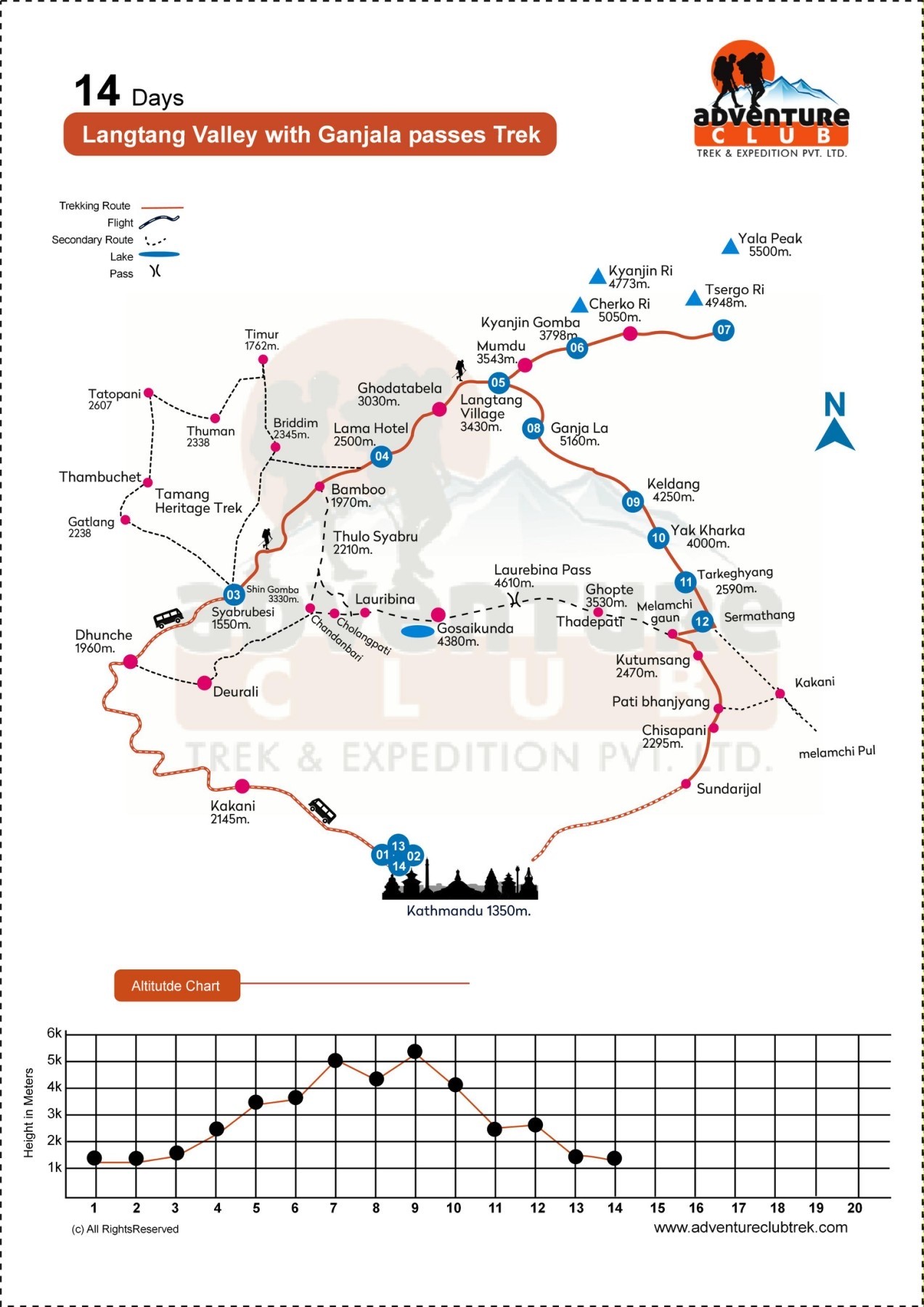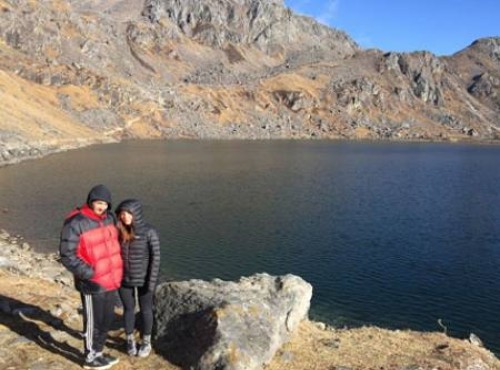Langtang Gang La pass Trip Highlights.
- UNESCO World Heritage Sites tour in Kathmandu
- Drive from Kathmandu to Syabrubesi in the vista of mountains, hills, country
- Combination of Langtang and Helambu
- Trek in the less crowded region close to Kathmandu Valley
- Diverse scenic elements forests, rivers, alpine, forests, pastureland, yak
- Panoramic view of snow-capped mountains — Langtang Ri, Langtang Himal, Langsisa, Ganjala Peak
- Experience the wonderful cultures of Indigenous Tamang, ethnic groups of Tibetan origin
- Old Buddhist shrines — Kyangjing Gompa
- View of the entire Langtang and Ganesh Himal Mountain ranges from Kyangjing Gompa
- Ascent to Tserko RI (5,033m/16,404ft)
- Diverse flora and Fauna -- rare endangered red panda, snow leopard, musk deer, bear, langur, etc.
- Ganja La pass (5,122m/16,800 ft.) is the highest point
- Trek through ancient villages, pastureland, and farmland in Helambu
- Old and significant Buddhist monasteries, stupas, and monuments
Langtang Valley with Ganjala passes Trek Overview
Ganja-La Pass Trek is very popular among adventurous trekkers who want to test their level of audacity. It's in the Langtang Region, a narrow valley below northern Tibet's central Himalayan Range. The Langtang Valley is a great place to visit Tibetan villages and Tamang Villages. You can also climb small peaks to see glaciers. Langtang Valley has various natural wonders, including blooming rhododendrons and lush and green bamboo bamboos. The Himalayas are capped with snow, and there are majestic waterfalls. This is one of the most diverse trekking routes near Kathmandu. This trek allows you to climb small peaks and visit Tibetan and Tamang villages while remaining at a low altitude.
The Langtang Valley Ganja La Pass Trek can be a little more complex than other treks within the Langtang area. It is a rewarding trek, with beautiful views of nature and Tibetan culture. The Langtang Valley is a great place to go trekking. It's exciting, fun and compact. You can traverse the lower Himalayan Foothills in just a few days to reach the active Himalayan Glaciers. The beautiful Langtang Valley has many side treks, circuit treks, and other options. You can also climb high mountains or traverse mountain passes.
The Langtang Valley Ganja La Pass Trek starts with a scenic seven-hour drive to Syabrubesi. The trek begins with a scenic 7-hour drive from Kathmandu to Syabrubesi. We then hike up to Mundu (3,403m), passing through the Langtang village and continuing to the Langtang Valley. We then continue to Kyangjin Gompa, where we will acclimate for a few hours. The valleys and riverbeds that surround Kyangjin Gompa are beautiful. Tserko Ri (5001m) offers a mesmerizing view of the Langtang Himalayan Ranges. This includes peaks like Langtang Lirung (7 246m), Kimshung (6781), and Yansa Tsenji 6575m.
The trek gets more difficult as the altitude rises. You can see Shishapangma (813m) and Langtang Lirung (813m), both stunning views from the top. We descend to Keldang and Yak Kharka before continuing to Tarke Gyang. Many Buddhist monuments and monasteries will be visible. We can see nature and villages as we trek from Sermathang to Malemchi Puul Bazaar. After 2 hours, we drive back to Kathmandu.
Conquering the Langtang Valley Ganja La Pass Trek would be an incredible achievement. This trail is seldom used due to its difficulty and the need for basic mountaineering knowledge. It is a wonderful feeling to overcome a challenge and succeed.
Best Time for the Langtang Ganja La Pass Trek
Spring (March, April, and May)
Spring is one of the most ideal seasons for the Langtang Valley Ganja La Pass Trek in Nepal. During this time, the Langtang National Park bursts into life, with vibrant pink, red, and yellow rhododendron blooms blanketing the forests. The air is filled with the refreshing scents of pine and maple, enhancing your trekking experience. Wildlife activity in the region increases as animals emerge from their winter slumber, and if you're lucky, you might spot the endangered red panda along the trail. The weather in spring is generally stable, offering cool, warm, and dry conditions that make for comfortable and enjoyable trekking.
Autumn (September, October, and November)
Autumn is widely considered the best time for the Ganja La Pass Trek in the Langtang Region. This season is characterized by moderate temperatures and consistently clear weather, perfect for trekking. The trails are dry and well-maintained, free from the mud and slipperiness of the monsoon season. Additionally, there are fewer leeches and mosquitoes to contend with. Under the bright blue skies, the mountain views are stunning. Peaks like Langtang Lirung, Ganesh Himal, Himalchuli, and Dorje Lakpa are visible in all their glory, along with breathtaking vistas of the surrounding valleys and landscapes. Autumn provides an unparalleled trekking experience with unobstructed views and comfortable trail conditions.
What is Food Like on the Langtang Trek?
During the Langtang Trek, all meals — breakfast, lunch, and dinner — are provided. In Kathmandu, only breakfast is included. We also host welcome and farewell dinners for our guests.
During the trek:
- Breakfast and Dinner: Served at tea houses or lodges where you stay overnight.
- Lunch: Provided at tea houses along the trekking route.
You can choose from a variety of cuisines, including Nepali, continental, Tibetan, and Indian dishes. We prioritize your health by ensuring meals are nutritious and made with locally sourced organic ingredients. Seasonal fruits are also offered. During climbing sessions, freshly cooked, hygienic meals are prepared for you. If you are a vegetarian, please inform us in advance so we can accommodate your dietary preferences.
What is Accommodation Like on the Langtang Trek?
In Kathmandu, you will stay in a three-star standard hotel. During the trek, accommodations are in the best available tea houses. All stays are on a twin-sharing basis. A single supplement can be arranged upon request for an additional cost. Please note that services in tea houses can be quite basic due to the remote location. We will do our best to arrange rooms with attached washrooms, but in some areas, such facilities may not be available.
What is Drinking Water Like on the Langtang Trek?
While Adventure Club provides all meals during the trek, drinking water is not included. You can use and treat local water from tea houses or along the trail. Treatment methods include chlorine or iodine tablets or a steripen. Be sure to allow sufficient time for the tablets to dissolve completely (approximately 30 minutes).
Mineral water is available for purchase along the trail:
- At lower elevations, a liter costs around USD 1.
- At higher elevations, the cost may rise to USD 4.
Keep this in mind, as the expense can add up. Tea houses typically provide good quality water for free, but it still needs to be treated.








